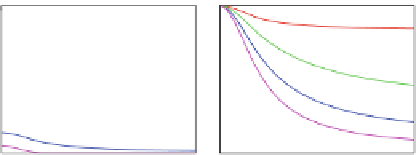Biomedical Engineering Reference
In-Depth Information
1
0.8
0.6
0.4
0.2
0
0
2
4
6
8
10
0
2
4
6
8
10
D [nm]
D [nm]
Fig. 9.10
The asymptotic value of the EOF as a function of the distance between the subsystems
for different temperatures (0 K—
red curve
,40K—
green curve
,80K—
blue curve
, 120 K—
violet
curve
).
Left panel
corresponds to the initial state (
9.28
)andthe
right panel
corresponds to the
initial state (
9.29
)
that the reservoir can distinguish the subsystems only by their location in space.
This single non-vanishing element is enough to prevent complete disentanglement
at any temperature and for any coupling strength. Only when the distance between
the system grows, dephasing is able to decrease this element to the extent sufficient
for the total destruction of entanglement. This distance effect is shown in Fig.
9.10
,
where we plot the asymptotic (long-time) value of the EOF.
The effect of spatial separation between the systems is very clearly visible
for the second initial state [Eq. (
9.29
)], which involves only this resilient off-
diagonal element (see Fig.
9.10
, right). Here, the entanglement is robust, if the
systems overlap (see also right panel of Fig.
9.9
) but becomes fragile as soon as
the separation between the systems is comparable to their size. This demonstrates
that the distance between the subsystems is the physical parameter that governs the
crossover between the two regimes of entanglement decay.
9.4
Collective Effects in the Luminescence
In this section, we analyze purely radiative effects, i.e., we assume that the DQD
system interacts only with its photon surrounding. For the wide-gap semicon-
ductors (with energy gap of the order of 1 eV) which we are investigating, the
zero-temperature approximation may be used at any reasonable temperature. The
Hamiltonian of the system is now
H
=
H
DQD
+
H
DQD
−
rad
,
where the exciton Hamiltonian
H
DQD
is defined by the formula (
9.3
)and
H
DQD
−
rad
is the interaction Hamiltonian describing collective coupling of the DQD to radiative
reservoir in the Dicke limit (Eq. (
9.6
)).
Since the ground state
are the eigenstates of
the carrier Hamiltonian, the nontrivial effects take place only in the single-exciton
|
00
and the biexcitonic state
|
11


















































